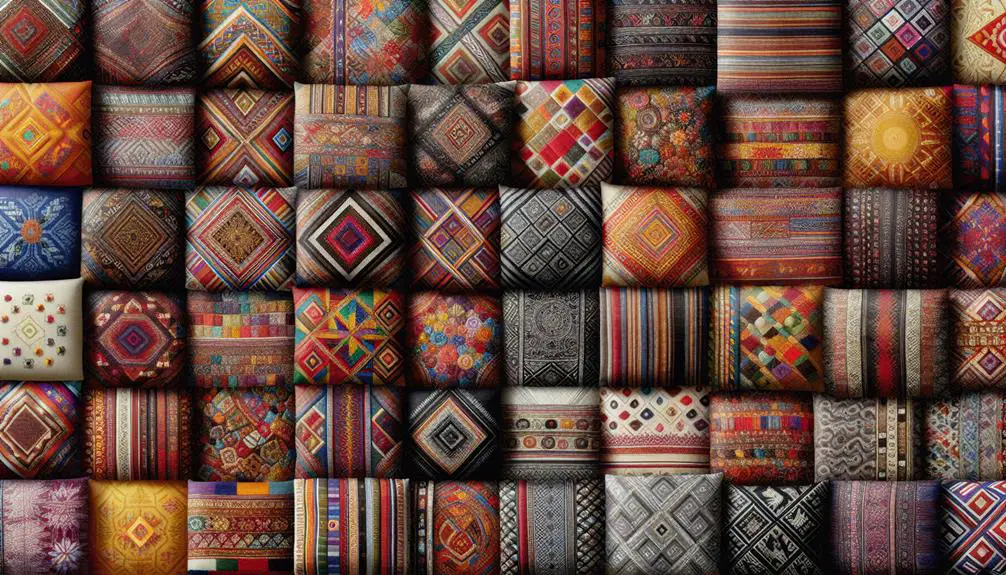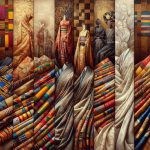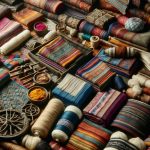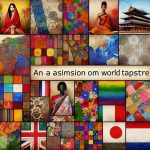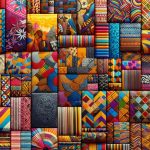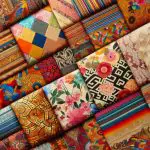Imagine the vibrant hues of a kente cloth, its geometric patterns telling stories of African heritage and pride. You're not just looking at fabric; you're witnessing centuries of tradition woven into every thread. Fabrics worldwide do more than cover our bodies—they connect us to our roots, narrate our histories, and showcase our artistry. Whether it's the intricate block prints from India or the luxurious silk kimonos of Japan, each piece highlights the unique cultural significance and craftsmanship of its origin. Curious about how these traditions have been preserved and evolved over time?
Table of Contents
Key Takeaways
- Fabrics often symbolize cultural identity, heritage, and values, reflecting the history and beliefs of a community.
- Traditional textiles like Indian handlooms and African Kente cloth use unique techniques and patterns to convey messages and stories.
- Many cultures, such as Japanese and Chinese, use specific materials and dyeing methods to achieve distinctive, luxurious textiles.
- Craftsmanship in textiles, such as European lace or Middle Eastern embroidery, showcases artistic expression and technical mastery.
- Techniques like Peruvian weaving and Indonesian batik are integral to cultural education and have a significant global influence on fashion.
Traditional Textiles of India
Renowned for its rich history and vibrant colors, India's traditional textiles showcase the country's diverse cultural heritage. When you explore India's textile traditions, you'll discover centuries-old techniques like block printing and handloom weaving, which have been perfected over generations.
Block printing involves intricately carved wooden blocks dipped in natural dyes to create stunning patterns on fabric. Each stamp tells a story, reflecting the skilled craftsmanship passed down through the ages.
In addition to block printing, handloom weaving plays a pivotal role in Indian textiles. This labor-intensive process involves manually operating looms to create fabrics with unique textures and designs. It's not just about weaving threads together; it's an art form that requires a deep understanding of patterns, color combinations, and rhythm.
You'll also find that natural dyes, derived from plants, minerals, and insects, are essential to Indian textiles. These dyes produce vibrant hues that are eco-friendly and sustainable.
Furthermore, intricate embroidery adds another layer of beauty and sophistication. Techniques like zardozi, kantha, and mirror work showcase the meticulous attention to detail and artistic flair that define Indian embroidery.
African Kente Cloth
When you explore African Kente cloth, you'll notice its vibrant patterns and rich symbolism. Each color and design carries historical significance, reflecting the values and stories of the Ashanti people.
Understanding Kente cloth helps you appreciate its role in cultural identity and heritage.
Symbolism and Patterns
African Kente cloth, with its vibrant colors and intricate patterns, stands as a powerful symbol of cultural identity and heritage. Each hue you see woven into the fabric holds deep color symbolism, conveying messages that transcend mere aesthetics. For instance, gold represents wealth and royalty, while blue signifies peace and harmony. Understanding these colors allows you to grasp the cultural significance embedded in each piece of Kente cloth.
Traditional motifs in Kente cloth aren't just artistic expressions but are laden with meaning. Patterns like 'Sika Futuro' (Gold Dust) symbolize prosperity, whereas 'Nkyinkyim' (Zigzag) represents life's twists and turns. As you explore these motifs, you'll appreciate how they encapsulate the wisdom and values of the African communities that create them.
Today, Kente cloth has transcended its traditional confines, finding modern interpretations in fashion and art. Designers worldwide incorporate these age-old patterns into contemporary styles, making Kente a global phenomenon. By recognizing the blend of traditional motifs with modern interpretations, you can see how this fabric remains relevant, preserving its cultural essence while adapting to current trends.
Historical Significance
Rooted in centuries-old traditions, Kente cloth holds deep historical significance that you'll find captivating. Originating from the Ashanti Kingdom in Ghana, this vibrant fabric is more than just a textile—it's a symbol of African heritage and identity. Woven with intricate patterns and rich colors, each piece of Kente cloth tells a story, reflecting the weaver's skill and the community's cultural values. You won't just see a fabric; you'll witness a living proof of ancient traditions.
Kente cloth has had a significant global impact, transcending borders and becoming a symbol of African pride and unity. Its intricate designs and bold colors have made it a staple in celebrations and important ceremonies, reinforcing its role in cultural preservation.
When you explore Kente's textile history, you'll uncover its origins as royal attire, reserved for Ashanti nobility. Today, it stands as a powerful emblem of resilience and continuity.
Japanese Kimono Fabrics
You'll find that Japanese kimono fabrics are rich in tradition and artistry. They use materials like silk and cotton, and the dyeing techniques have a long history.
Each pattern on a kimono holds deep cultural symbolism, reflecting various aspects of Japanese heritage.
Traditional Kimono Materials
Japan's traditional kimonos are crafted from luxurious fabrics like silk, hemp, and cotton, each chosen for its unique texture and cultural significance. When you think of kimonos, the first fabric that likely comes to mind is silk. It's not just any silk—Japanese silk production is an art form, refined over centuries to achieve unparalleled quality and luster.
The meticulous process involves rearing silkworms, harvesting the cocoons, and spinning the fibers into threads. This silk is then expertly woven into fabric, which serves as the canvas for intricate designs and patterns.
Hemp and cotton are also integral to kimono craftsmanship. Hemp, known for its durability and breathability, was historically favored for summer kimonos. It's perfect for keeping cool in Japan's humid climate. Cotton, versatile and soft, has been widely used for informal kimonos and undergarments.
Dyeing methods are equally critical in the creation of kimono fabrics. Techniques like shibori and yuzen transform plain textiles into stunning works of art. Mastery of these dyeing methods allows artisans to infuse each kimono with vivid colors and intricate patterns, making every piece unique.
Dyeing Techniques History
The history of dyeing techniques in Japanese kimono fabrics reveals a rich tapestry of innovation and tradition that elevates each garment to a work of art. When you explore these methods, you'll uncover how artisans have skillfully harnessed natural dyes to create vibrant and lasting colors. These dyes, derived from plants, minerals, and even insects, offer a sustainable and authentic approach to fabric coloration.
To understand the mastery behind these techniques, consider these three significant methods:
- Shibori: This ancient tie dye technique involves intricate folding, twisting, and binding of fabric before dyeing. The resulting patterns are both unique and mesmerizing.
- Katazome: A stencil dyeing technique where rice paste is applied to create resist patterns, allowing for intricate and repeatable designs on the fabric.
- Yūzen: This freehand painting method uses rice paste as a resist and allows for detailed and colorful illustrations, often depicting nature scenes.
Each of these techniques showcases the relentless pursuit of perfection and creativity in Japanese culture. By mastering these dyeing methods, you'll gain a deeper appreciation for the artistry that transforms simple kimono fabrics into timeless masterpieces.
Cultural Symbolism in Patterns
When you examine the patterns on Japanese kimono fabrics, you'll discover a rich language of cultural symbolism that tells stories of nature, seasons, and societal values. Each motif carries deep cultural significance. For instance, cherry blossoms, or 'sakura,' symbolize the beauty and impermanence of life, reflecting Japan's appreciation for the fleeting nature of existence.
Bamboo patterns denote resilience and strength, values deeply ingrained in Japanese society. The artistic expression in kimono patterns goes beyond mere aesthetics. Traditional techniques like 'yuzen' dyeing and 'shibori' tie-dyeing have been passed down through generations, ensuring that the cultural heritage remains intact.
These methods allow artisans to create intricate designs that convey complex meanings, such as cranes for longevity and chrysanthemums for rejuvenation. Modern interpretations of these traditional techniques have allowed kimono fabrics to evolve while retaining their essence. Contemporary designers incorporate new materials and technologies, creating pieces that resonate with today's fashion sensibilities without losing their cultural roots.
Peruvian Weaving Techniques
Rooted in ancient traditions, Peruvian weaving techniques showcase a rich cultural heritage that continues to thrive today. You'll find that traditional weaving methods aren't just a craft but a cultural tapestry interwoven with history and identity.
Peruvian color schemes, characterized by vibrant reds, deep blues, and earthy browns, are meticulously chosen to reflect natural landscapes and ancestral beliefs. The Andean textile traditions go beyond mere aesthetics. Each piece holds cultural significance, serving as a storyteller of Andean life.
For instance, patterns and symbols often depict agricultural cycles, spiritual rituals, and historical events. This makes every woven item a unique, meaningful artifact.
To gain mastery over these techniques, consider the following:
- Understand Peruvian Color Schemes: Learn how weavers use natural dyes from plants, minerals, and insects to create distinct hues.
- Master Traditional Weaving Methods: Engage with backstrap and pedal loom techniques, which require patience, skill, and a deep respect for tradition.
- Appreciate Cultural Significance: Recognize that every textile has a story, often linked to the weaver's community and heritage.
Chinese Silk Legacy
Imagine the unparalleled elegance and historical depth that Chinese silk brings to the world of fabrics. From the ancient Silk Road to modern haute couture, China's silk legacy has shaped both art and commerce.
You can't overlook the intricacies involved in silk production, a process that has been perfected over millennia. Beginning with the cultivation of mulberry trees to feed silkworms, to the delicate unwinding of silk threads from cocoons, each step requires meticulous care and expertise.
Chinese silk isn't just about the material; it's a canvas for artistic designs that tell stories of dynasties, nature, and folklore. Think of the legendary motifs of dragons and phoenixes, meticulously woven into the fabric, each symbolizing power and immortality.
When you hold a piece of Chinese silk, you're not just feeling a luxurious fabric; you're touching a piece of history.
Mastering the art of Chinese silk involves understanding its cultural significance and the skills passed down through generations. So, as you explore the world of fabrics, remember that Chinese silk stands as a tribute to human ingenuity and artistic brilliance. It's not merely fabric; it's a legacy woven with threads of history and art.
Native American Textiles
Few cultural artifacts capture the rich heritage and artistry of Native American communities like their textiles. As you explore these intricate works, you'll discover the mastery and deep cultural significance embedded within Native American weaving techniques. Each piece tells a story, reflecting the values, history, and spiritual beliefs of its creators.
Traditional Navajo textiles stand out for their remarkable beauty and spiritual symbolism. Navajo weavers, often guided by spiritual visions, create rugs and blankets that serve not only as functional items but also as sacred objects. The complex patterns and vivid colors are imbued with meanings that convey messages of harmony, balance, and the interconnectedness of life.
To gain a deeper understanding, consider these three key aspects:
- Techniques: Navajo weaving involves a vertical loom and specific methods passed down through generations, ensuring the preservation of this cultural art.
- Materials: Authentic Navajo textiles often use hand-spun wool dyed with natural pigments, reflecting a strong connection to their environment.
- Purpose: Beyond their beauty, these textiles hold ceremonial importance, used in rituals and as symbols of status and identity.
European Lace Craftsmanship
While Native American textiles showcase a rich tapestry of cultural heritage, European lace craftsmanship offers a glimpse into a tradition of intricate and delicate artistry. You'll find that lace evolution in Europe is a tale of innovation and refinement.
Originating in the 16th century, it quickly became a symbol of status and elegance. Techniques like bobbin and needle lace were meticulously perfected by artisans in regions like Belgium and France, setting standards that still influence today's lace designs.
Understanding modern applications of European lace is essential. It's not just limited to bridal wear; contemporary fashion designers incorporate it into everyday apparel, accessories, and even home decor. This adaptability underscores its timeless appeal and versatility.
Keeping up with European lace trends reveals its ongoing global influence. Designers worldwide draw inspiration from classic patterns, blending them with modern aesthetics to create fresh, innovative pieces. Whether it's a delicate lace collar or an intricate tablecloth, the European impact is undeniable.
Indonesian Batik Patterns
Indonesia's batik patterns illustrate a profound cultural heritage and artistic tradition that captivates with their complexity and vividness. When you explore these intricate designs, you'll find that each pattern tells a story, often rooted in mythology or nature. The meticulous process involves wax-resist dyeing, where artisans apply hot wax in detailed designs before dyeing the fabric. This technique guarantees that each piece is a unique masterpiece.
Modern adaptations of batik have allowed it to thrive in contemporary fashion, making it accessible to younger generations and global markets. Designers integrate batik into everyday wear, from casual dresses to high-end couture, showcasing its versatility and timeless appeal.
The global influence of Indonesian batik is undeniable, as it has become a symbol of cultural exchange and mutual appreciation.
Here are three key aspects of its worldwide impact:
- Education: Workshops and courses on batik art have sprouted worldwide, nurturing a deeper understanding and respect for this traditional craft.
- Fashion: International designers incorporate batik into their collections, boosting its visibility on global runways.
- Cultural Diplomacy: Batik serves as a cultural ambassador, promoting Indonesian heritage in international forums and exhibitions.
Middle Eastern Embroidery
Middle Eastern embroidery captivates with its intricate designs and rich history, reflecting the diverse cultures of the region.
You'll find that Palestinian cross stitch, for instance, is more than just visually stunning—it's a profound symbol of cultural heritage. Each stitch tells a story, with patterns often passed down through generations. The vibrant colors and geometric shapes aren't just for show; they hold deep connections to Palestinian identity and history.
Turkish needlework offers another layer of artistic expression within Middle Eastern embroidery. Known for its delicate, floral motifs and precise technique, Turkish embroidery showcases an immense skill set. You can witness the meticulous craftsmanship in each piece, often used to adorn household items, clothing, and ceremonial fabrics.
This form of needlework isn't just art but an embodiment of Turkish cultural pride and aesthetic sophistication.
When you explore Middle Eastern embroidery, you're delving into a world where fabric becomes a canvas for storytelling and cultural preservation. By understanding the significance behind Palestinian cross stitch and Turkish needlework, you gain a deeper appreciation for the artistry and history that these intricate designs represent.
Frequently Asked Questions
How Do Fabrics Influence Modern Fashion Trends Globally?
You see fabrics influencing modern fashion trends globally through fabric diversity and cultural expression. Fabric innovation drives designer influence, allowing unique styles and cultural elements to blend, creating a dynamic and ever-evolving fashion landscape.
What Are the Environmental Impacts of Fabric Production?
You need to understand fabric production's environmental impacts. It involves significant water usage, waste, and pollution. Prioritize sustainability by choosing eco-friendly materials and reducing consumption to help mitigate these harmful effects.
How Is Fabric Used in Contemporary Art Installations?
Imagine fabric as a chameleon in contemporary art installations. You'll see it transforming spaces, creating immersive sensory experiences. Artists employ fabric as a medium to evoke emotions, challenge perceptions, and engage audiences on multiple levels.
What Role Do Fabrics Play in Global Economic Trade?
You'll find that fabrics play an essential role in global economic trade. Their trade impacts are immense, driving the textile industry's economic importance. They're integral to global supply chains, influencing various sectors and economies worldwide.
How Are Traditional Fabric-Making Techniques Being Preserved Today?
Did you know that over 60% of traditional techniques are preserved through community workshops? You can see preservation efforts firsthand in these vibrant settings, ensuring ancient skills pass to new generations, keeping cultural legacies alive.
- How Does Ring Spun Cotton Affect Garment Fit and Shape Retention? - August 13, 2024
- What Are the Challenges in Producing Ring Spun Cotton? - August 13, 2024
- Is Ring Spun Cotton Suitable for Plus-Size Clothing? - August 13, 2024

